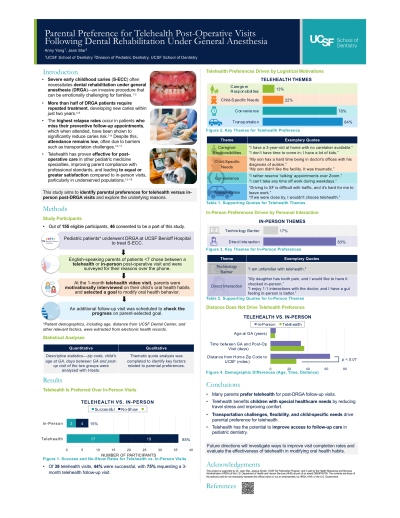Other
251 - Parental Preference for Telehealth Post-Operative Dental Visit Following DRGA


Anny Yang (she/her/hers)
Dental Student
University of California - San Francisco-3yr
University of California, San Francisco
San Francisco, California, United States
Jean Star, DDS, MPH
Assistant Professor
University of California, San Francisco
University of California San Francisco
San Francisco, California, United States
Jean Star, DDS, MPH
Assistant Professor
University of California, San Francisco
University of California San Francisco
San Francisco, California, United States
Presenting Author(s)
Co-Author(s)
Program Director(s)
Objective: Dental rehabilitation under general anesthesia (DRGA) is widely used for severe early childhood caries (S-ECC) but faces high relapse rates. Prompt preventive follow-up care is critical to prevent future caries, yet completion rates remain low. This study assesses parental preferences for telehealth versus in-person follow-up visits and identifies factors influencing these choices.
Methods: Brief telephone interviews were conducted with parents of children who recently completed DRGA at UCSF Benioff Children's Hospital. Parents were offered a telehealth or in-person post-operative visit and interviewed for the reasons behind their choice. Descriptive statistics (e.g., zip code, child’s age at DRGA) of the two groups were analyzed with t-tests, and qualitative analysis identified key themes related to parental preferences.
Results: Among 46 participants, 85% chose a telehealth video visit for follow-up, while 15% preferred an in-person visit. Key reasons for preferring telehealth included transportation challenges, convenience, child-specific needs (e.g., special healthcare needs, dental anxiety), and caregiver responsibilities. Conversely, those preferring in-person visits valued a provider’s direct assessment (86%) and lived farther from the dental center, averaging 104.2 kilometers compared to 49.6 kilometers for those preferring telehealth (P < .01). The visit completion rate for telehealth was 44%, with 75% of participants who completed a telehealth visit requesting another telehealth follow-up visit.
Conclusion: Parents prefer telehealth for DRGA follow-up, with many desiring continued telehealth care. Transportation barriers remain the primary motivator for telehealth preference, regardless of distance. Future research should explore strategies to improve visit completion rates and assess telehealth’s impact on children’s oral hygiene habits.
Identify Supporting Agency and Grant Number: Research supported by Health Resources and Services Administration (HRSA) of the U.S. Department of Health and Human Services (HHS) - D85HP45706

.jpg)